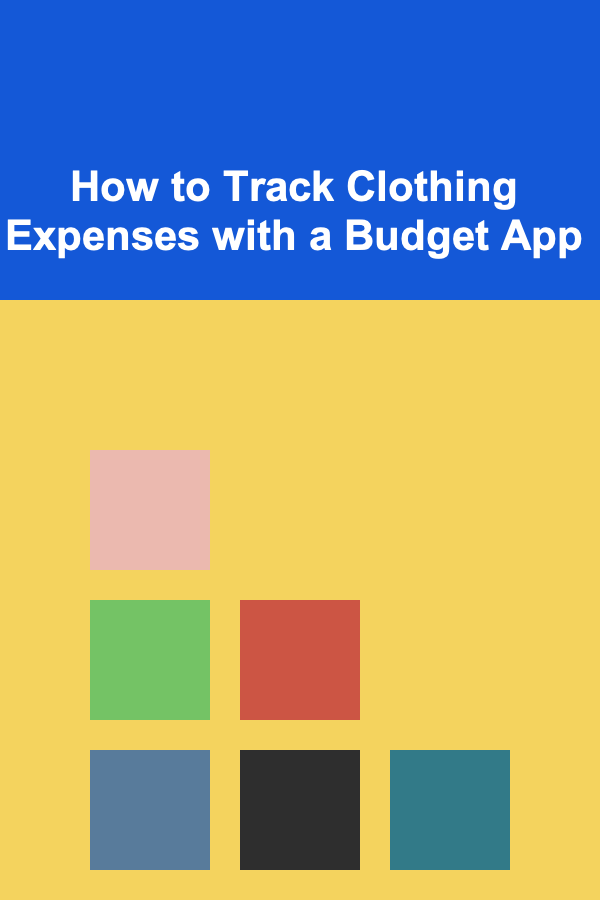
How to Track Clothing Expenses with a Budget App
ebook include PDF & Audio bundle (Micro Guide)
$12.99$5.99
Limited Time Offer! Order within the next:

Managing personal finances is an essential skill that everyone should master. One aspect of personal finance that often gets overlooked is clothing expenses. Whether it's buying new clothes for work, casual outings, or special occasions, clothing expenses can quickly add up and take a chunk out of your budget. This is where a budget app can be incredibly helpful.
Budget apps are digital tools designed to track your spending, categorize expenses, and help you stay within your financial limits. Tracking your clothing expenses using a budget app not only helps you control overspending but also provides insight into your purchasing habits, allowing you to make more informed decisions moving forward. In this article, we will explore how to effectively track clothing expenses with a budget app, the benefits of doing so, and how to make the most out of this tool.
Understanding the Importance of Tracking Clothing Expenses
Before diving into the practical steps of using a budget app, it's important to understand why tracking clothing expenses is so essential. Clothing is a recurring expense that can sometimes be difficult to control. People often purchase clothing items without considering their overall budget, leading to impulse buying or excessive spending. In fact, according to surveys, clothing is one of the most common areas where people overspend.
Here are a few reasons why tracking your clothing expenses is important:
- Avoid Impulse Purchases: It's easy to get caught up in the excitement of a sale or the latest fashion trend. However, tracking your expenses can help you avoid unnecessary purchases that don't fit into your overall budget.
- Financial Awareness: By tracking your clothing expenses, you gain awareness of how much money you're actually spending on clothes each month. This can help you adjust your budget to ensure you're not overspending in this category.
- Long-Term Savings Goals: Understanding how much you're spending on clothing allows you to save for other financial goals. Whether it's buying a house, saving for retirement, or going on vacation, cutting down on clothing expenses can help you redirect funds to these bigger goals.
A budget app helps you gain control over your spending and creates a financial blueprint that aligns with your long-term objectives.
Choosing the Right Budget App for Clothing Expenses
The first step in tracking clothing expenses is choosing the right budget app. While there are numerous budget apps on the market, it's important to pick one that aligns with your needs. The best budget apps for tracking clothing expenses will allow you to categorize your spending, set spending limits, and provide visual reports that help you assess your financial habits.
Here are a few key features to look for in a budget app:
- Expense Categorization: Choose an app that lets you create custom categories or has pre-set categories for clothing and fashion-related purchases. This will make it easier to track specific types of spending.
- Real-Time Tracking: An app that tracks your expenses in real time is a huge advantage. This allows you to see immediately if you've overspent on clothing.
- Budget Creation: The ability to set a specific budget for your clothing expenses is essential. Your app should allow you to define how much you can afford to spend on clothes each month.
- Syncing Capabilities: Look for an app that syncs across multiple devices. This will help you track your expenses no matter where you are.
- Reports and Analytics: The app should offer reports or charts that break down your clothing expenses over time, helping you to identify spending patterns.
Popular budget apps like Mint , YNAB (You Need a Budget) , PocketGuard , and EveryDollar offer many of these features. Review each app to find one that suits your financial tracking style and needs.
Setting Up Your Clothing Budget in the App
Once you've chosen your budget app, the next step is setting up your clothing budget. Creating a clothing budget is crucial for managing your spending in this category. It's important to be realistic and honest about how much you can afford to spend on clothes without impacting other areas of your financial plan.
Step-by-Step Guide:
- Identify Your Clothing Needs: Begin by evaluating your clothing needs. Are you purchasing clothing for work? Are you buying trendy pieces for the upcoming season? Understanding your clothing requirements can help you set a reasonable budget.
- Set a Monthly Budget: Once you've assessed your needs, set a monthly budget for clothing expenses. A good rule of thumb is to allocate a small percentage of your monthly income to clothing, typically around 5-10%. However, the exact amount will depend on your financial situation and goals.
- Categorize Your Purchases: Most budget apps will allow you to categorize your expenses. Make sure to create a "Clothing" or similar category and track every clothing-related purchase under this label. You can break this down further if you'd like to track specific types of clothing (e.g., casual wear, workwear, accessories).
- Track and Adjust: As the month progresses, keep track of your clothing purchases. If you notice you're nearing your limit, consider reducing your spending in the category for the remainder of the month.
Setting up a clothing budget is one of the most effective ways to keep your spending under control while still allowing you to purchase the items you need.
Categorizing Clothing Expenses for Better Insights
One of the advantages of using a budget app is the ability to categorize your expenses. This provides a more detailed look into where your money is going, making it easier to adjust your budget accordingly. For example, if you notice that you're spending too much on accessories or fast fashion, you can take steps to cut back in those areas.
Breaking Down Clothing Categories:
- Workwear: Clothing you purchase for your job, such as professional attire, uniforms, or accessories.
- Casual Wear: Clothes for everyday wear, such as jeans, t-shirts, and casual dresses.
- Seasonal Clothing: This includes clothing purchases related to a change in season, such as winter coats or summer shorts.
- Special Occasions: Clothing bought for special events, like weddings, parties, or vacations.
- Accessories: Items like shoes, bags, jewelry, and hats.
- Fitness and Sportswear: Athletic clothing, workout gear, or activewear.
Tracking your clothing expenses in such detail allows you to see patterns and make more intentional purchases. For example, if you find that you're overspending on casual wear, you can limit that spending in future months.
Tracking Clothing Purchases in Real-Time
Real-time tracking is one of the best features of budget apps. It allows you to keep a close eye on your spending as it happens, which is a great way to avoid impulsive purchases. Many budget apps allow you to sync your credit and debit cards with the app, automatically categorizing transactions as they occur. This is particularly useful for clothing purchases, as it helps you stay on top of your budget without having to manually input each expense.
Tips for Real-Time Tracking:
- Enable Notifications: Most budget apps send real-time notifications whenever a transaction is made. By enabling notifications, you can immediately assess whether a clothing purchase fits within your budget.
- Use the App's Barcode Scanner: Some apps offer a barcode scanning feature, allowing you to scan an item in-store and immediately track the cost. This helps you stay mindful of how much you're spending while you're shopping.
- Check Your Budget Regularly: Make it a habit to check your budget app at least once a week. This gives you an opportunity to adjust your spending before you hit your clothing budget limit.
Real-time tracking empowers you to make better financial decisions by giving you up-to-date information on your clothing expenses.
Analyzing Clothing Expenses Over Time
Once you've tracked your clothing expenses for a few months, it's time to review the data. Budget apps typically generate reports or visual analytics that show you how much you're spending in each category. By analyzing these reports, you can identify trends and gain insights into your spending behavior.
Key Insights to Look For:
- Monthly Trends: Are there particular months where you tend to spend more on clothing? For example, you might spend more during seasonal sales or around holiday shopping times.
- Category Breakdown: Do you spend more on accessories or workwear? Analyzing which types of clothing you're purchasing most can help you cut back in areas where you're overspending.
- Budget vs. Actual Spending: Review your budgeted amount against actual spending. If you consistently go over your clothing budget, it might be time to adjust your budget or reconsider your purchasing habits.
By reviewing these insights, you can make more informed decisions about your clothing purchases in the future and make adjustments to stay within your financial goals.
Setting Limits and Alerts to Stay on Track
One of the most powerful features of a budget app is the ability to set spending limits and alerts. With clothing expenses, setting a limit can help you prevent overspending and stick to your financial goals.
How to Set Effective Limits:
- Set Monthly Limits: Define a maximum amount you're willing to spend on clothing each month. The app will notify you when you're getting close to this limit.
- Set Alerts: Many apps allow you to set alerts that notify you when you're approaching or exceeding your clothing budget. This can help you make adjustments before it's too late.
- Use Categories to Set Specific Limits: If you tend to overspend in certain categories, like accessories or seasonal clothing, set individual limits for each category.
Setting limits and alerts ensures that you stay within your clothing budget without constantly having to monitor your spending.
Review and Adjust Your Clothing Budget Regularly
Your clothing needs and financial situation may change over time. Therefore, it's essential to review and adjust your clothing budget regularly. If you receive a pay raise or have a change in priorities, you might want to increase or decrease your clothing budget accordingly.
How to Adjust Your Budget:
- Increase or decrease limits: If you find that your clothing needs are changing (e.g., you need more workwear for a new job), you can increase your budget accordingly.
- Reassess your financial goals: If you're saving for a large purchase or goal, consider reducing your clothing budget temporarily to allocate more funds toward your savings.
Reviewing your budget ensures that it aligns with your current financial situation and goals.
Saving on Clothing Without Sacrificing Style
Using a budget app is not just about tracking how much you spend---it's also about saving money while still looking great. Here are some tips for cutting down on clothing expenses without sacrificing your personal style:
- Shop Sales and Discounts: Keep an eye out for seasonal sales or discount codes that can help you save money on your clothing purchases.
- Invest in Quality, Not Quantity: Rather than buying several low-cost items, focus on investing in a few high-quality pieces that will last longer.
- Thrift Shopping: Consider shopping at second-hand stores or online resale platforms. You can often find high-quality clothing for a fraction of the price.
By being strategic about your clothing purchases and using a budget app, you can maintain your style while keeping your finances intact.
Conclusion
Tracking your clothing expenses with a budget app is a practical and effective way to manage your personal finances. By setting a clothing budget, categorizing your purchases, and reviewing your spending patterns, you can stay on top of your financial goals while still enjoying the fashion you love. With the power of modern budget apps, staying within your clothing budget has never been easier. Whether you want to reduce unnecessary spending or save for long-term goals, tracking your clothing expenses is an essential step in achieving financial wellness.
Reading More From Our Other Websites
- [Personal Care Tips 101] How to Choose a Hair Serum for Hair Growth and Strengthening
- [Personal Care Tips 101] How to Use Mouthwash to Relieve Toothaches Temporarily
- [Horseback Riding Tip 101] The Health Benefits of Horseback Riding: Fitness, Balance, and Mental Wellness
- [Scrapbooking Tip 101] Top Must-Have Tools and Apps for Creative Digital Scrapbooks
- [Hiking with Kids Tip 101] Chasing Cascades: Kid‑Friendly Waterfall Hikes Perfect for Family Adventures
- [Personal Finance Management 101] How to Track Your Spending and Cut Unnecessary Costs
- [Home Holiday Decoration 101] How to Incorporate DIY Crafts into Your Holiday Decorations
- [Personal Financial Planning 101] How to Protect Your Wealth and Avoid Financial Scams
- [Home Soundproofing 101] How to Soundproof Your Home for a Peaceful Remote Work Environment
- [Organization Tip 101] How to Use Inventory Management Software for Your Home

Creating Passive Income by Investing in AI-Powered Deep Learning Products
Read More
How to Plan a Successful Home Party with Limited Time and Resources
Read More
How to Sell Vintage Watches on Etsy: A Comprehensive Guide
Read More
How to Invest in Climate-Friendly Transportation
Read More
How to Reduce Your Risk of Oral Health Issues
Read More
DIY Feng Shui Projects You Can Do This Weekend
Read MoreOther Products

Creating Passive Income by Investing in AI-Powered Deep Learning Products
Read More
How to Plan a Successful Home Party with Limited Time and Resources
Read More
How to Sell Vintage Watches on Etsy: A Comprehensive Guide
Read More
How to Invest in Climate-Friendly Transportation
Read More
How to Reduce Your Risk of Oral Health Issues
Read More